Top News
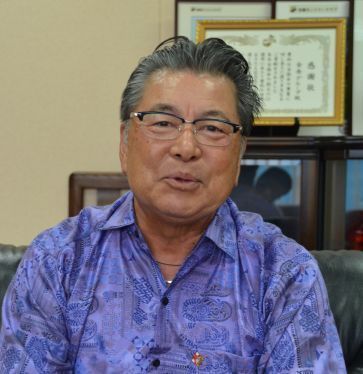
July 24, 2018 Ryukyu Shimpo
By Shoichiro Yonamine
The Henoko Okinawa Referendum Committee, which is aiming to put a prefectural referendum on the ballot asking whether or not to allow new base construction in Henoko, Nago, succeeded in collecting 60,000 signatures for their petition by the July 23 deadline.
Having well surpassed the minimum 23,000 signatures, representing 2% of eligible voters in Okinawa, the referendum is closer than ever to becoming reality.
We interviewed committee advisor Morimasa Goya (Kanehide Holdings Co., Ltd. Chairman) about the committee’s goals among other things.
– Tell us about the disagreement on the policies surrounding the referendum, resigning from the All-Okinawa Coalition, and joining the civil movement.
“In particular, the defeat in the January Nago mayoral election was big. During Onaga’s term as governor, we continue to lose mayoral elections.
The prime minister has been harping on this as if they had received tacit acceptance regarding the Henoko issue from the faction that had chosen to withdraw from making elections their battlefield.
If that is what they think, they should set the stage to hear the consensus from the Okinawan people directly.
Of course, creating the opportunity to ask the people of Okinawa their consensus is our greatest weapon, and my proposition was to use it as an effective means to revoke the permission for land reclamation work.
There are some who argue that the gubernatorial and national elections also reflect the will of Okinawans, and that it comes at no risk.
Resigning from the All-Okinawa Coalition was recognizing and cutting from my body a part of me that had become “necrotized” before it could spread to the rest of my body.”
– How have you come to view the movement formed by political amateurs?
“I think the idea was for us to be involved with the debate for our future, and see it to a solidified conclusion.
The manpower and money are overwhelmingly insufficient. However, our pure-heartedness has carried the message.
The condensed dissatisfaction and uneasiness in the people of Okinawa that is now spreading has through the petition led to many people coming to our side.
It has become the far-reaching actual All-Okinawa.
I think this civil movement has now come to an important crossroad.”
– What are your thoughts on realizing this referendum?
“If those in favor stay silent, and we overwhelm them lopsidedly, it cannot be truly called a victory.
I want to engage them in deeper discussion, and in that depth notice the discrepancies in their argument.
Those discrepancies may exist for us as well.
For that reason I am calling on those in favor of the ruling parties land reclamation work in Henoko to organize.
Without fail, we will do the same.
Bringing life to the debate is the most important thing of all.
One thing I am concerned about with regards to the actual referendum is the question itself.
In addition to ‘yes’ and ‘no,’ I do not want there to be a selection for ‘undecided.’ I want for each Okinawan to bring their spirit and their resolve, and show without retreat what kind of legacy they want to leave for their children and grandchildren.
This may be a bit of an intrusive question. However, I think it is the obligation of each and every living Uchinanchu today.
I want this to be the point that ends the division and opposition between Okinawans, and moves us along to the next debate.”
(English translation by T&CT and Sam Grieb)
Go to Japanese
July 18, 2018 Ryukyu Shimpo
On July 17 the Henoko Okinawan Resident Vote Assembly, which aims to enact an ordinance for a prefectural referendum asking whether citizens approve or disapprove of the land reclamation project at Henoko, held a press conference at the Prefectural Office and announced that the number of signatures necessary for the referendum were collected, reaching 33,722 in total.
In order for the Assembly to directly request that the governor enact a prefectural referendum ordinance, it is necessary to gather more than 23,000 signatures, which accounts for one-fiftieth of voters in the prefecture.
Collected signatures exceeded the necessary number by about 10,000.
If the procedures move forward smoothly and the proposal for the referendum is passed by the end of October, the referendum will be implemented between this fall and the end of next April.
The Assembly will carry out signature collection until the 23rd of this month and submit a list of signatures to election board at each municipality within ten days.
After an examination by each board, the Assembly will request that the governor enact the ordinance.
The governor must convene the prefectural assembly within twenty days from the request and submit a draft ordinance and related budget proposal.
As the prefectural assembly’s ruling party supports the referendum, the ordinance is expected to pass.
The governor will submit a draft of the ordinance to the Prefectural Assembly, and decide on a date for the referendum.
Given necessary procedures such as time for municipal assemblies to deliberate on supplementary budgets and make the referendum information known throughout Okinawa, the referendum is likely to be held in December at the earliest, after the gubernatorial election on November 18.
(English translation by T&CT and Megumi Chibana)
Go to Japanese
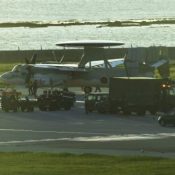
July 18, 2018 Ryukyu Shimpo
A Japan Air Self Defense Force (JASDF) E-2C airborne early warning aircraft stationed at Naha Air Base suffered a tire puncture shortly after landing at around 5:38 p.m. on July 17, while taxiing to the gate at Naha International Airport, causing the runway to shut down.
According to the Naha Airport Office, as of 8:00 p.m. the same day 46 flights had been either cancelled or redirected.
This paper estimates that including delays, the shutdown affected around 5,000 passengers on the 17th.
On the north end of the runway, the aircraft was unable to move on its own and had to be towed; the runway was able to resume operation at 7:19 p.m., after a one hour and 41 minute-long shutdown.
According to Naha Air Base, the punctured tire was the left tire on the front leg.
None of the five passengers aboard were injured.
There were no irregularities reported from the pre-flight check.
The aircraft, which is attached to the Airborne Early Warning Surveillance Group 603rd Squadron, was returning from a regular training flight.
A wheeled platform was placed under the punctured wheel, and the aircraft was towed to one of Naha Air Base’s maintenance hangars.
Two YS-11 turboprop airliners scheduled to land at Naha Air Base were also briefly redirected to the U.S. Air Force’s Kadena Air Base.
According to the airport office, rubber fragment from the ruptured tire were scattered on the runway, but all of the pieces were collected.
Nine flights were cancelled, eleven flights were re-directed to New Ishigaki Airport, five flights were sent back to their point of departure, and twenty-one flights were delayed, the longest delay being three hours and fourteen minutes.
It is believed that the effects of the runway closure will continue.
Naha Air Base Commander Hidetada Inazuki commented, “We have inconvenienced many people due to the closure of the runway. We will investigate the cause of the puncture, and do everything in our power to prevent it from reoccurring.”
On June 14, there was also an incident at Naha Airport, when a JASDF F-15 fighter rejected the direction of the air traffic controller and crossed over the stop-line in front of a runway, forcing a private aircraft to cancel their planned landing.
(English translation by T&CT and Sam Grieb)
Go to Japanese
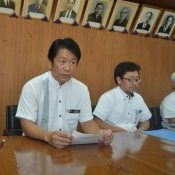
July 18, 2018 Ryukyu Shimpo Digital Edition
In the afternoon of July 18, Ishigaki City Mayor Yoshitaka Nakayama held a meeting at the city hall to announce that Hirae Ohmata of Ishigaki City will receive the Japan Ground Self-Defense Force (JGSDF) troops.
The decision was made during a special meeting that was held earlier in the day.
The press was not contacted about the announcement beforehand since it was hastily decided on after the round-table conference with journalists that same day.
After the announcement, the decision was relayed to the Ministry of Defense.
The mayor commented, “We agreed to this with the understanding that there is a need to station troops in Ishigaki Island.”
Regarding the request to sell off city land, he said, “We will move forward with the proper paperwork for administrative affairs.”
(English translation by T&CT and Chelsea Ashimine)
Go to Japanese
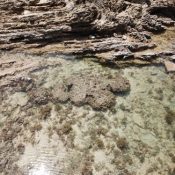
July 17, 2018 Ryukyu Shimpo
According to the Okinawa Defense Bureau’s (ODB) notification to the Okinawa Prefectural Government (OPG), as of July 17 there is one month remaining until the day soil depositing into the ocean begins as part construction of a replacement facility in Henoko, Nago City for Futenma Air Station.
The ocean area in Oura Bay and Henoko is richly abundant in terms of wildlife, with over 5300 species of plants and animals living there.
Since the Japanese government has begun work in the ocean, endangered dugongs have not been observed in the area.
Experts indicate that transplanting large coral found within the planned land reclamation site is essential.
The OPG has requested that the seaweed beds on which dugong feed on and in which smaller creatures live be transplanted.
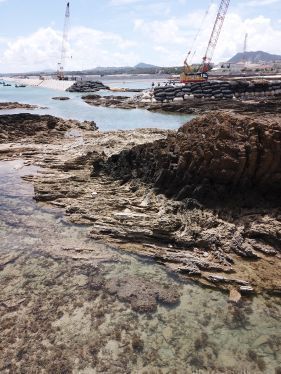
Colony of coral living in the ocean area planned for land reclamation, near the seawall construction at Cape Henoko on the shore of Camp Schwab in Henoko, Nago at around 2:00 p.m. on July 13 (photograph taken via small drone)
Regardless, the central government is taking the approach of performing land reclamation work without transplanting.
From the perspective of environmental conservation, many problems are becoming apparent as the time set for soil deposits draws near.
A colony of large cactus coral (Pavona decussata) has been found within the planned area for construction of the replacement facility in Henoko.
Ending on July 16 the Ryukyu Shimpo took some photographs using a small drone.
Because a portion of the colony has died, and the section requested for transplant is less than 1-meter in diameter, the Ministry of Defense (MOD) insists that it is ineligible for transplant. However, experts indicate that this is inconsistent with set criteria.
The cactus coral is in the vicinity of the N3 seawall within the planned for land reclamation.
Large coral in the Poritidae family also live in the vicinity, but the central government holds that neither coral is eligible for transplantation.
Citizens found these corals in January and pointed out the importance of transplanting them.
In response to this, the MOD implemented an underwater survey in June.
The survey concluded that the coral’s degree of coverage is less than 5 percent and that most of the top layer is dead, so the central government expressed that its plan is to not transplant.
The head of conservation for the Nature Conservation Society of Japan (
NACS-J), Mariko Abe, spoke about the MOD’s plan.
She said, “There are 22 Poritidae colonies listed as eligible for transplant by the MOD, and some among those colonies are also partially dead.
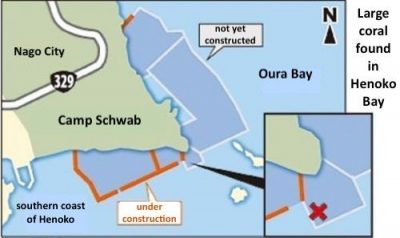
Colony of coral living in the ocean area planned for land reclamation, near the seawall construction at Cape Henoko on the shore of Camp Schwab in Henoko, Nago at around 2:00 p.m. on July 13 (photograph taken via small drone)
The criteria are inconsistent. If any of those were to be transplanted, the coral colony we are addressing should also be transplanted.”
She continued, “I think it’s odd that the Japan Coral Reef Society determines whether or not to transplant coral based on its size.
It’s simply common sense that the coral should be transplanted.”
(English translation by T&CT and Erin Jones)
Go to Japanese
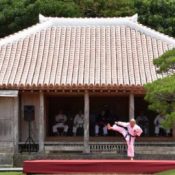
July 8, 2018 Ryukyu Shimpo
On July 7 at the Shikinaen Garden in Naha City, the executive committee for the Okinawa Karate International Tournament held a ceremony to commemorate the opening of the first Okinawa Karate International Tournament on August 1. Eight people, including chairmen, advisers and counselors from four Okinawa Karate associations (Zen Okinawa Karatedo Renmei, Ken Karatedo Renmei, Okinawa Karate Kobudo Renmei, and Ken Karatedo Rengokai) gave powerful demonstrations in front of the World Heritage site.
In addition to praying for the success of the Tournament, they pledged to disseminate Karate worldwide from Okinawa, the birthplace of Karate.
Nine-year-old Aoi Sinzato who trains at Uechi-ryu Kenseikai saw the demonstrations and said, “They looked so cool!” Twelve-year-old Ryuho Senaga said, “Karate is the pride of Okinawa. I am excited about the International Tournament.”
(English translation by T&CT and Megumi Chibana)
Go to Japanese
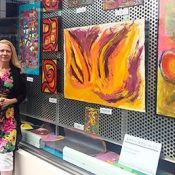
July 12, 2018 Ryukyu Shimpo
Catherine Jane Fisher is holding an art exhibition meant to transmit the messages of peace and love, titled Nuchi du Takara (Life is a Treasure), in Shibuya, Tokyo.
Fisher is an Australian and a resident of Tokyo who protests U.S. military crime and is calling for revision of the U.S.-Japan Status of Forces Agreement (SOFA).
Prior to the commencement of soil depositing work in Henoko, which is set for August as part of construction of the new base, she whole-heartedly hopes to draw many people’s attention to Henoko from the middle of the city.
The exhibition will be open through July 31. Fisher’s exhibition is visible in the window of the art supply shop Uematsu, located right by Shibuya Station.
Her works titled Phoenix and Henoko are both multicolored yet have red as their base tone.
Throngs of people pass by the shop, and people have been observed taking notice of Fisher’s paintings.
In 2002 a U.S. soldier raped Fisher in Yokosuka City, Kanagawa Prefecture.
Based on this experience, Fisher makes continuous efforts to support victims of sexual assault.
Immediately after suffering this experience, her works largely became darker with more use of black.
She has expressed her desire to never make works that gloomy again, and she does not want to allow crimes like this to happen anymore. Furthermore, she insists that until the U.S.-Japan SOFA is revised crime in Okinawa will not change at all.
Fisher has her reasons for pursuing such action.
She feels she has a duty for the sake of her grandchildren and the coming generation.
If someone were to ask her why she did not simply do nothing she would be at a loss for words.
With these thoughts in mind she continues to create her works.
(English translation by T&CT and Erin Jones)
Go to Japanese
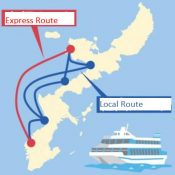
July 14, 2018 Ryukyu Shimpo
The Daiichi Koutsu Sangyo Co. Ltd. is participating in a plan to run a high-speed ferry connecting Naha and Motobu Ports.
With the increase of rental cars used by tourists visiting Okinawa, congestion on the roads continue to worsen, and the ferry aims to relieve the burden on the region by making a shift towards travel over the water.
Additionally, establishing routes to Motobu Port via modes of transportation such as highway buses is also expected to expand tourism to the northern parts of the island.
As a test of the ferry’s suitability, the company will be exploring both a direct route between Naha and Motobu, as well as a route that will make local stops at ports such as Chatan, Onna, and Nago.
However, this is not the first attempt at the route connecting Naha and Motobu.
Previously, The joint public-private venture “Okinawa Marine Jet Tourism,” which Okinawa Prefecture invested in, had a high-speed ship dubbed the “Marine” that ran a route between Naha, Motobu, and Iejima, it was shuttered in February of 2000 after experiencing profitability concerns.
Subsequently, profitability has become a focal point of this new endeavor.
Daiichi Koutsu analyzes that the Marine, which had a capacity of over 200 passengers, was too large of a ship for the actual demand for passage oversea, and over time operating costs began to mount.
This time, the plan is to use a smaller high-speed ship with a capacity of around 70 passengers to increase seat occupancy, and aims to secure profitability by adhering to a “low-cost carrier” strategy.
(English translation by T&CT and Sam Grieb)
Go to Japanese
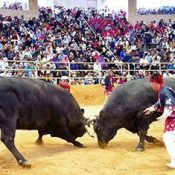
July 11, 2018 Ryukyu Shimpo
By Mariko Uezu
During the meeting on July 10, Uruma City Board of Education School Superintendent Hiromi Kadekaru announced the decision to designate the Uruma City’s bullfighting as one of the city’s Intangible Folk Cultural Properties.
The bullfighting parties concerned were happy to hear the news.
They were filled with deep emotion since they had hoped for many years that the bullfighting would be designated as a cultural property.
Outside of Okinawa, bullfighting is designated as a cultural property in Uwajima City, Ehime Prefecture and Oki Islands, Shimane Prefecture.
This will be the first time within the Okinawa Prefecture that bullfighting is designated as a cultural property.
Last summer, the Uruma City Bullfighting Association submitted the application for designating bullfighting as one of Uruma City’s Intangible Folk Cultural Properties to the Uruma City Board of Education.
On June 18, the city’s Council for the Protection of Intangible Cultural Properties reported to the board that the bullfighting was evaluated for its historical depth and a culture that represents the locale, which are much appreciated by the citizens.
Uruma City Bullfighting Association Chairman Shuji Ohshiro said, “The bullfighting culture that our ancestors established greatly encourages tourism and the training of young members.”
Okinawa Prefecture Bullfighting Association Chairman Masakazu Kouchi said, “I hope the 18 other Okinawan municipalities with bullfighting associations will designate bullfighting as a cultural property. I’d like to help with that process.”
He thereby hoped that Uruma City’s decision will lead to a prefecture-wide phenomenon.
Uruma City Tourist Association Chief Director Moriyuki Kamimura was also enthusiastic.
He said, “I would like to promote bullfighting as a traditional culture far and wide in and outside of Okinawa via plans like offering reserved bullfighting events.”
Miyagi Island’s hiitachi-ato was also designated a historical landmark.
(English translation by T&CT and Chelsea Ashimine)
Go to Japanese
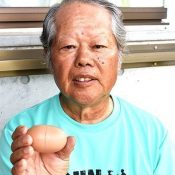
July 5, 2018 Ryukyu Shimpo
Seventy-one-year-old Syunichi Okuhara from Furugen in Yomitan village found out that his hen had layed a capsule-looking egg.
The form is like a “gacha-gacha,” the capsules in which small toys are packed, with a straight line in the middle of the egg shell.
Okuhara widened his eyes, saying, “I’ve seen 5000 eggs before but this is the first time I’ve seen one like this.”
He found the “gacha-gacha egg” at noon on June 12. He first thought, “Someone put in a toy as a joke.”
However, the chicken cage was locked and there was no sign of a break-in from outside.
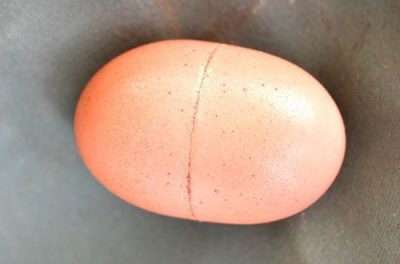
The “gacha-gacha egg” with a line in the middle of the egg shell
The egg also felt like a normal egg.
Teruo Kinjo, a 54-year-old animal doctor at the Okinawa Zoo and Museum, was also surprised to see the egg, saying, “I’ve never seen an egg like this.
I think it’s rare.” He guesses that the line in the middle is a dent on the egg shell, commenting “perhaps there was some irregular thing that happened when the egg shell was being formed.”
(English translation by T&CT and Sayaka Sakuma)
Go to Japanese
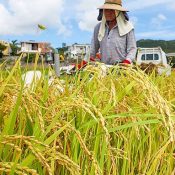
June 26, 2018 Ryukyu ShimpoThe harvest of the first crop of rice has started in Kin town, which is known as one of the foremost rice-producing areas in the prefecture.
Many farmers worked hard on harvesting golden rice swinging in the summer breeze under the strong sun in the rice paddies around town on June 25.
Sixty-seven-year-old Kennei Miyagi and two other farmers worked in the paddy in Yaka. Miyagi said, “The first crop has grown well and we have a good harvest. The second crop starts in August, so we have to hurry up,” as he wiped sweat from his forehead.
(English translation by T&CT and Sayaka Sakuma)
Go to Japanese













 Webcam(Kokusai Street)
Webcam(Kokusai Street)


